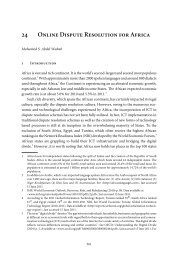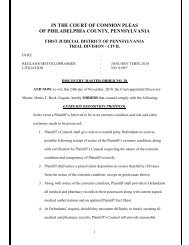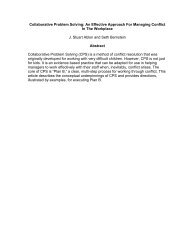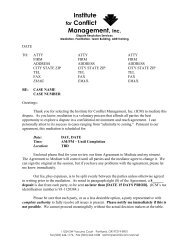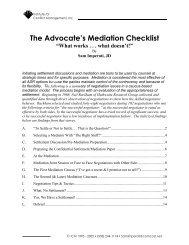Navigating the Mediation Process PDF - Mediate.com
Navigating the Mediation Process PDF - Mediate.com
Navigating the Mediation Process PDF - Mediate.com
You also want an ePaper? Increase the reach of your titles
YUMPU automatically turns print PDFs into web optimized ePapers that Google loves.
D I S P U T E R E S O L U T I O N J O U R N A L<strong>Navigating</strong> The <strong>Mediation</strong> <strong>Process</strong>:Over<strong>com</strong>ing Invisible Barriers toResolution<strong>Mediation</strong> involves many keyrelationships beyond that of plaintiff anddefendant that could present barriers toresolution. The author identifies someof <strong>the</strong>se relationships, shows how <strong>the</strong>ycan create barriers to a successfulmediation, and offers suggestions forover<strong>com</strong>ing <strong>the</strong>se barriers.BY BENNETT G. PICKERBennett G. Picker is a partner in <strong>the</strong> Philadelphia law firm of Stradley, Ronon,Stevens & Young, LLP, where he concentrates his practice in mediation andarbitration. Mr. Picker is a Fellow of both <strong>the</strong> International Academy of Mediatorsand <strong>the</strong> American College of Civil Trial Mediators, and serves on <strong>the</strong> panels of <strong>the</strong>American Arbitration Association and <strong>the</strong> CPR International Institute for ConflictPrevention and Resolution. He is also a member of <strong>the</strong> Executive Committee of<strong>the</strong> American Arbitration Association’s Board of Directors. Mr. Picker is <strong>the</strong> authorof <strong>the</strong> “<strong>Mediation</strong> Practice Guide: A Handbook for Resolving Business Disputes”(2nd edition) published in 2003 by <strong>the</strong> ABA Section on Dispute Resolution. Mr.Picker’s e-mail address is bpicker@stradley.<strong>com</strong>.Author’s Note: In order to protect <strong>the</strong> confidentiality of participants, <strong>the</strong> anecdotesin this article represent a <strong>com</strong>posite of actual mediations.Most mediation advocates and party representatives, when preparing for mediation,primarily focus on one relationship that significantly impacts resolution—<strong>the</strong>relationship between plaintiff and defendant. Given <strong>the</strong>ir background as trial lawyers,most advocates largely concentrate on <strong>the</strong> positions of plaintiff and defendant when consideringfacts, rights, obligations, claims, defenses, experts, damages, credibility issues and probableout<strong>com</strong>es. More sophisticated advocates also explore ano<strong>the</strong>r dimension of <strong>the</strong> relationshipbetween plaintiff and defendant—<strong>the</strong>ir underlying needs and interests, including strategicobjectives, timing, reputation, <strong>the</strong> potential for restructured relationships and <strong>the</strong> need to avoidfuture disputes.Reprinted with permission from <strong>the</strong> Dispute Resolution Journal, vol. 61, no. 3, August-October 2006,a publication of <strong>the</strong> American Arbitration Association, 335 Madison Avenue, New York, NY 10017-4605,212.716.5800, www.adr.org.
D I S P U T E R E S O L U T I O N J O U R N A Lits outside counsel, and (3) <strong>the</strong> participants and o<strong>the</strong>r“stakeholders” in <strong>the</strong> dispute. This article highlights <strong>the</strong>seinvisible barriers and suggests approaches for advocates andmediators to better navigate <strong>the</strong> mediation process andmaximize <strong>the</strong> potential for successful out<strong>com</strong>es.Relationships Between Representatives ofOne PartyA trial lawyer often pauses in <strong>the</strong> middle of a negotiation,settlement conference, or mediation, and wonders, “Whyhasn’t <strong>the</strong> o<strong>the</strong>r side made a realistic offer? Don’t <strong>the</strong>yunderstand <strong>the</strong>ir risk?” The question ignores <strong>the</strong> fact that“<strong>the</strong>y”—those on <strong>the</strong> o<strong>the</strong>r side—frequently do not functionas a cohesive unit with <strong>the</strong> capacity to ei<strong>the</strong>r make acollective decision or speak with one voice.For example, in a recent mediation involving an allegedbreach of a long-term supply agreement, <strong>the</strong> corporateplaintiff’s representatives each entered <strong>the</strong> process withconsiderably different perspectives on <strong>the</strong> “ideal out<strong>com</strong>e”for <strong>the</strong> <strong>com</strong>pany. As <strong>the</strong> mediator facilitating this dispute, Ispent well over an hour in a private caucus session with <strong>the</strong>serepresentatives, including <strong>the</strong> <strong>com</strong>pany’s CEO, CFO,general counsel and general manager. After thoroughlyexploring <strong>the</strong> positions and interests of <strong>the</strong> parties, we begandiscussing <strong>the</strong> plaintiff’s response to a proposal made by <strong>the</strong>defendant. Initially, <strong>the</strong> plaintiff’s representatives stood intotal disagreement with each o<strong>the</strong>r.The process of mediation, however, involves many more keyrelationships, beyond <strong>the</strong> primary one of plaintiff anddefendant, which are often invisible to <strong>the</strong> mediationparticipants and <strong>the</strong>ir advocates and frequently presentbarriers to resolution. These relationships include thosebetween: (1) representatives of each party, (2) <strong>the</strong> client andThe CEO argued that <strong>the</strong> defendant should pay a large sumof money, readily admitting that <strong>the</strong> result would directlyaffect <strong>the</strong> size of <strong>the</strong> bonus he would receive at <strong>the</strong> end of <strong>the</strong>year. The CFO expressed concern about <strong>the</strong> timing of anypayment, conscious of maximizing reported earnings in <strong>the</strong>current year. The general counsel of <strong>the</strong> <strong>com</strong>pany warnedthat everyone in <strong>the</strong> room represented <strong>the</strong> “client”—<strong>the</strong><strong>com</strong>pany— and had a duty as fiduciaries to maximizeshareholder value. Accordingly, he argued that since WallStreet values long-term streams of revenue more highly thana one-time payment of cash, <strong>the</strong> agreement should reflectdifferent pricing terms to allow for an anticipated stream ofrevenue. The general manager who originally determinedthat <strong>the</strong> defendant breached <strong>the</strong> contract simply wanted acourt to affirm <strong>the</strong> breach had occurred and that she hadmade <strong>the</strong> correct decision.All charts are furnished by <strong>the</strong> author. Copyright 2006 ©Bennett G. PickerDuring <strong>the</strong> caucus, I conducted what was, in essence, aninternal mediation with <strong>the</strong> plaintiff’s representatives to getall of <strong>the</strong>m on <strong>the</strong> same page. When I finally returned to <strong>the</strong>defendant’s room, <strong>the</strong> o<strong>the</strong>r side greeted me with <strong>the</strong>question, “What took <strong>the</strong>m so long? Don’t <strong>the</strong>y understand<strong>the</strong> strength of our positions?” Without revealing why <strong>the</strong>2 AUGUST/OCTOBER 2006
D I S P U T E R E S O L U T I O N J O U R N A Lrepresentatives of <strong>the</strong> plaintiff had been stuck, I delivered<strong>the</strong> good news of a reasonable counteroffer to <strong>the</strong>defendant’s proposal. The negotiation moved forwardbecause crucial <strong>com</strong>munication had been privatelystimulated in one room—among and between <strong>the</strong>representatives of <strong>the</strong> plaintiff. Even though <strong>the</strong> CEO had<strong>the</strong> ultimate decision-making power in this dispute, internaldifferences of opinion presented a serious potential barrier toresolution—a barrier invisible to <strong>the</strong> defendant.Competing in-house concerns <strong>com</strong>mon to all large<strong>com</strong>panies frequently hinder a corporate party’s ability to<strong>com</strong>e to a mediation session with a cohesive strategy forsuccess. For example, in a mediation involving an allegedbreach of an asset purchase agreement, a heretofore invisiblearise from unrealistic promises made by counsel about <strong>the</strong>chance of success at trial. Failing to deliver periodic<strong>com</strong>munications about <strong>the</strong> status of litigation or <strong>the</strong> risks andcosts involved in continuing <strong>the</strong> litigation leaves clients illpreparedto make timely decisions on settlement. Making aconscious effort to <strong>com</strong>municate with and solicit thoughtsfrom clients throughout <strong>the</strong> life of <strong>the</strong> dispute will helpmediation advocates better prepare for mediation and moreeffectively represent clients.A major source of <strong>the</strong> <strong>com</strong>munication breakdown betweenan attorney and client often begins with counsel’s delivery ofbad news to <strong>the</strong> client, generally concerning <strong>the</strong> risk of<strong>com</strong>plete or partial loss at trial. In many instances, <strong>the</strong> clientwill respond by saying, “I thought you were my lawyer. IfCompeting in-house concerns <strong>com</strong>mon to all large <strong>com</strong>paniesfrequently hinder a corporate party’s ability to <strong>com</strong>e to amediation session with a cohesive strategy for success.barrier to resolution surfaced during a private caucus when<strong>the</strong> representatives of two <strong>com</strong>pany divisions began to argueabout whose budget would “take <strong>the</strong> hit” for any settlement.Similarly, a mediation involving a product liability claimgot bogged down on <strong>the</strong> defendant’s side whenrepresentatives tried to internally resolve whe<strong>the</strong>r <strong>the</strong>payment would <strong>com</strong>e out of <strong>the</strong> budget of <strong>the</strong> operatingdivision or <strong>the</strong> budget of <strong>the</strong> office of legal counsel. Toobtain <strong>the</strong> best possible result, <strong>the</strong> parties’ advocates shouldflag and address <strong>the</strong>se internal issues with <strong>the</strong>ir clientsbefore sitting down at <strong>the</strong> mediation table.Relationships Between ClientRepresentatives and Outside CounselProfessor Gerry Williams, one <strong>the</strong> nation’s leading scholarsin <strong>the</strong> field of negotiations, studied <strong>the</strong> settlement activity ofmore than 20 lawyers over a period of several years.Professor Williams concluded that <strong>the</strong> principal reasondisputes failed to settle most often stemmed from adisconnect in <strong>the</strong> relationship between <strong>the</strong> outside lawyerand <strong>the</strong> client, ra<strong>the</strong>r than from differences between <strong>the</strong>parties in litigation.you don’t believe in my case, I’ll find myself ano<strong>the</strong>rlawyer,” or something along <strong>the</strong>se lines. At this point,counsel may simply back off and leave <strong>the</strong> client withunrealistic expectations, ra<strong>the</strong>r than taking <strong>the</strong> hard road andreframing <strong>com</strong>munications more effectively to keep <strong>the</strong>client well informed. In a recent mediation, trial counselprivately confided to me at <strong>the</strong> end of a dispute, “Thank youfor telling my client what I could not say. I really appreciatedyour help.”While it may be difficult to be candid with <strong>the</strong> client about<strong>the</strong> weaknesses of its case, I believe that mediation advocatesshould face that task. By helping clients understand <strong>the</strong>weaknesses as well as <strong>the</strong> strengths, advocates will leave lessup to chance and ultimately better serve <strong>the</strong> client's needs.Based on my own experience as a mediator, I agree that <strong>the</strong>attorney-client relationship merits careful examination inevery mediation. A model relationship between a mediatingparty and its counsel will foster ongoing open<strong>com</strong>munication flowing in both directions concerning <strong>the</strong>management of <strong>the</strong> case. Conflicts in this relationship oftenDISPUTE RESOLUTION JOURNAL 3
D I S P U T E R E S O L U T I O N J O U R N A LIn a number of cases in recent years, I have found thatattorney-client fee agreements create a misalignment ofincentives, which, in turn, create a barrier to settlement.For example, counsel in a <strong>com</strong>plex intellectual propertycase I mediated stated in a private caucus that a proposedsettlement, which his client viewed as favorable, wasunacceptable to him because hiscontingent fee would be too small.His standard practice, which hediscussed with his client at <strong>the</strong> timeof signing <strong>the</strong> written fee agreement,included refusing any settlementthat did not give him a triple returnon his invested time. He and Iresolved this problem after a verydifficult private conversation aboutprofessional responsibility.In ano<strong>the</strong>r recent mediationinvolving a shareholder dispute, <strong>the</strong>plaintiff refused a very goodsettlement, stating that his goalswere vindication and punishment of<strong>the</strong> o<strong>the</strong>r side for its arrogant andunlawful behavior. Usuallyescalating attorneys’ fees deter“billable” clients from pursuing<strong>the</strong>ir “principles” in protracted litigation. However, whenas in this case, <strong>the</strong> attorney agreed to a contingent fee, <strong>the</strong>client was not faced with <strong>the</strong> issue of cost when making itsdecision with regard to settlement. We ultimately resolvedthis dispute, too, by helping <strong>the</strong> client refocus on whe<strong>the</strong>rgoing to trial or settling through mediation would betterserve his ultimate goals and objectives.The attorney-clientrelationship meritscareful examinationin every mediation.Conflicts in thisrelationship oftenarise from unrealisticpromises made bycounsel about <strong>the</strong>chance of successat trial.Many individuals and entities outside <strong>the</strong> formal circle of<strong>the</strong> dispute often wield influence over <strong>the</strong> decision makersparticipating in mediation. One obvious example is aninsurance <strong>com</strong>pany that provided coverage to <strong>the</strong>defendant in <strong>the</strong> dispute being mediated. The insurancecontract usually gives <strong>the</strong> insurer control over <strong>the</strong>resolution of <strong>the</strong> dispute, so itsparticipation is important, but itmay not wish to participate. Askilled mediator will explore <strong>the</strong>issue of a carrier’s participationwell before entering mediation.Insurers are not <strong>the</strong> only non-partieswith an interest in <strong>the</strong> dispute. O<strong>the</strong>rpeople outside of <strong>the</strong> mediationroom may be “stakeholders” in that<strong>the</strong>y play an important role in <strong>the</strong>decision maker’s own life, and<strong>the</strong>refore have an interest in <strong>the</strong>out<strong>com</strong>e of <strong>the</strong> mediation. Thesepeople include a spouse, relative,partner, or friend, especially onewho happens to be a lawyer,accountant, or o<strong>the</strong>r type ofbusiness advisor with a professionalgrasp of <strong>the</strong> dispute. A decisionmaker may feel pressure from or be persuaded by any of<strong>the</strong>se persons, causing ano<strong>the</strong>r invisible barrier toresolution. In all of <strong>the</strong>se situations, a skilled mediator willprobe during caucus sessions to identify persons who arenot present in <strong>the</strong> room who may have influence over <strong>the</strong>decision maker, and adopt strategies to over<strong>com</strong>e anypossible barriers.Relationships Between Participants in<strong>Mediation</strong> and O<strong>the</strong>r StakeholdersWhile <strong>the</strong>re are an infinite number of potentialstakeholders who could potentially influence <strong>the</strong> decisionmakers in a particular mediation, in my experience, <strong>the</strong>issue of “authority” creates <strong>the</strong> greatest invisible barrierto resolution. In advance of <strong>the</strong> mediation, I alwaysdiscuss <strong>the</strong> need to have persons with full settlementauthority at <strong>the</strong> mediation. However, parties sometimesbenchmark a zone of settlement in advance of <strong>the</strong>mediation and <strong>the</strong>n send representatives who haveauthority to settle only up to <strong>the</strong> top end of <strong>the</strong> zone. Oncein <strong>the</strong> mediation, <strong>the</strong> party representatives often recognizethat <strong>the</strong>ir side’s evaluation of <strong>the</strong> case was skewed byselective perception or advocacy bias and that <strong>the</strong>y needmore authority to settle. Most of <strong>the</strong> time, partyrepresentatives will place a call to a higher-level executivein a <strong>com</strong>pany to obtain additional authority; but <strong>the</strong>problem is that this person has not been participating in4 AUGUST/OCTOBER 2006
D I S P U T E R E S O L U T I O N J O U R N A L<strong>the</strong> mediation process, and thus will not have <strong>the</strong> “buy-in”necessary to make an informed decision.Experienced mediators face <strong>the</strong> challenge of identifying asmany invisible relationships and authority issues as possiblein advance of <strong>the</strong> mediation, encouraging <strong>the</strong> parties to havea person with <strong>the</strong> greatest authority possible in <strong>the</strong> mediationroom, and resolving issues that invariably occur regardlessof any preventative efforts. In many situations, I have ei<strong>the</strong>rcalled higherlevel executives during <strong>the</strong> course of <strong>the</strong>mediation to involve <strong>the</strong>m in <strong>the</strong> process, or postponed amediation to include <strong>the</strong>se persons.In some disputes, a party representative in <strong>the</strong> mediationmay have <strong>the</strong> necessary authority, but harbors concern abouta higher-level executive criticizing his or her decision tosettle above a figure previously identified in a <strong>com</strong>panymeeting. One <strong>com</strong>pany executive candidly remarked that hewould ra<strong>the</strong>r blame a judge or jury for making a bad decisionthan shouldering criticism from <strong>the</strong> executive officers of his<strong>com</strong>pany for “conceding too much.”ConclusionTo maximize <strong>the</strong> opportunity for a successful mediation,both advocates and all party representatives should endeavorto identify all of <strong>the</strong> potential invisible barriers to settlementwell in advance of <strong>the</strong> first mediation session. Theadvocates, in particular, should pay extra attention to <strong>the</strong>relationships among and between <strong>the</strong> representatives of <strong>the</strong>client because <strong>the</strong>re are likely to be private agendas andpolitics at work. Moreover, counsel to <strong>the</strong> parties and <strong>the</strong>party representatives should make every effort to identify<strong>the</strong> real client or clients; it is helpful to ask who in <strong>the</strong><strong>com</strong>pany really “owns” <strong>the</strong> dispute. Then, <strong>the</strong>y can assemblea team to define goals, discuss “authority,” and try to align<strong>the</strong> varying interests and perspectives of <strong>the</strong> key players.Invisible barriers are difficult for party representatives torecognize and over<strong>com</strong>e without assistance. A skilledmediator can help <strong>the</strong> parties identify and over<strong>com</strong>e <strong>the</strong>sebarriers.■DISPUTE RESOLUTION JOURNAL 5


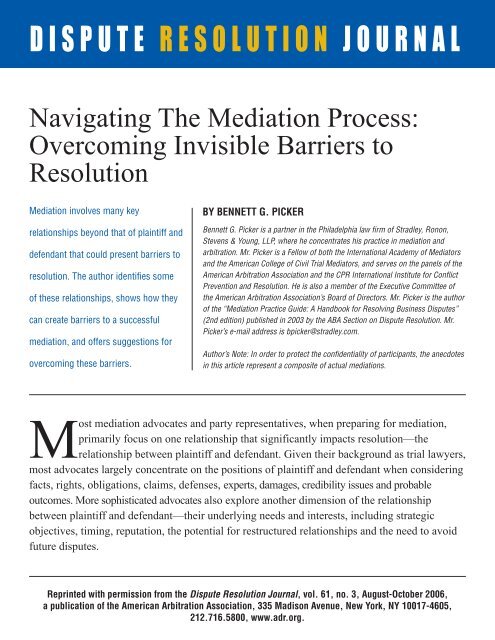
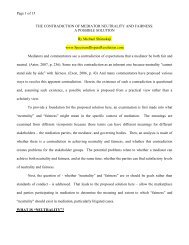
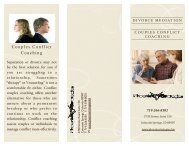
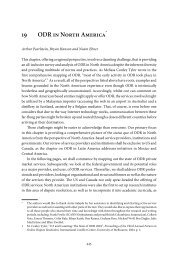
![Settlement Agreement Form [Agreement] - Mediate.com](https://img.yumpu.com/50682143/1/190x245/settlement-agreement-form-agreement-mediatecom.jpg?quality=85)

